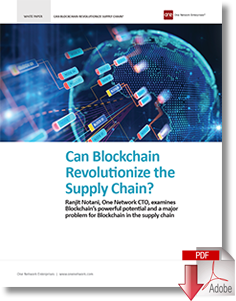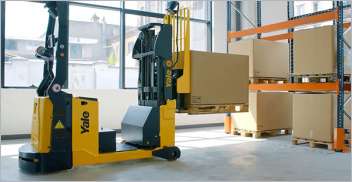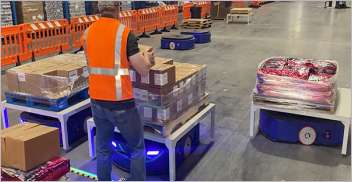Two blue-chip players in today’s global supply chain marketplace recently announced that they plan to introduce a “transformational” service designed to expedite ocean cargo shipping and mitigate supply chain risk.
Maersk, which has partnered with the Chinese e-commerce provider Alibaba, is now joining IBM in a widely celebrated effort to introduce blockchain technology to link supply chain managers, freight forwarders, other ocean carriers, ports and Customs authorities.
The blockchain solution based on the Hyperledger Fabric and built by IBM and Maersk is designed to help manage and track the paper trail of tens of millions of shipping containers across the world by digitizing the supply chain process from end-to-end to enhance transparency and the highly secure sharing of information among trading partners.
When adopted at-scale, the solution has the potential to save the industry billions of dollars, says Maersk.
“We expect this to not only reduce the cost of goods for consumers but also make global trade more accessible to a much larger number of players from both emerging and developed countries,” says Ibrahim Gokcen, Maersk’s chief digital officer.
In an interview, analysts noted that the Danish supercarrier is positioned to identify the best ocean lanes for the initial launch of this collaboration.
“Maersk will certainly know where the potential choke points are in the supply chain,” says Martha Bennett, Principal Analyst at Forrester Research, London, UK.
“The regulatory barriers will also have to be addressed,” she says. Just how soon this strategy will be implemented is “the $64 million dollar question,” says Bennett.
There are other questions, she adds. “Then there’s the industry ‘buy-in’ to consider. How many other ocean carriers will want to join? Finally, there’s getting official approval.”
Closing the Deal
Bennett is optimistic about the deal, however, and feels that once the “solicitation for participation” has been made, real traction will move it forward.
Bridget van Kralingen, senior vice president, Industry Platforms, IBM, is even more bullish on the prospects.
She told Supply Chain Management Review that blockchain technology can potentially provide “massive savings” when used broadly across the ocean shipping industry “ecosystem.”
In a nutshell, this is how it works:
- Each participant in a supply chain ecosystem can view the progress of goods through the supply chain, understanding where an in-transit container is located. They can also see the status of Customs documents or view bills of lading and other data.
- Detailed visibility of the container’s progress through the supply chain is enhanced with the real-time exchange of original supply chain events and documents.
- No one party can modify, delete or even append any record without the consensus from others on the network.
- This level of transparency helps reduce fraud and errors, reduce the time products spend in the transit and shipping process, improve inventory management and ultimately reduce waste and cost.
The solution enables the real-time exchange of original supply chain events and documents through a digital infrastructure, or data pipeline, that connects the participants in a supply chain ecosystem.
“We are not terribly concerned about government regulators creating obstacles for its implementation,” says van Kralingen.
“They are not in the business of making money, after all. They just want to ensure that we are providing another layer of security and financial settlement.”
Holy Grail?
In an interview with The New York Times, Frank Yiannas, Walmart’s vice president of food safety said he is convinced “that maybe we were onto the Holy Grail,” when driving a separate deal with IBM in recent months.
He added that much of his faith is driven by the belief that blockchain brings together digital marginal economics, unit level entity identification and cutting-edge cyber-security.
A new study conducted by Deloitte, “Industry 4.0 and cyber risk: Security in an age of connected production,” also finds that blockchains have the potential to help mitigate current cyber-security risks by streamlining the flow of goods and information.
But skeptics abound, including Kevin O’Marah, chief content officer of SCM World, who surmises: “It feels a bit like RFID déjà vu.”
“While blockchain may now be at the peak of Gartner’s “hype cycle,” its next stop could be the “trough of disillusionment.”
O’Marah notes, however, that blockchain does not require devices like RFID, nor does it need reading hardware to be effective.
“Understanding blockchain is now imperative, but this does not necessarily mean you should hurry into any projects or even pilots at this stage,” he cautions.
Too Much Hype?
Steve Banker who heads up the Supply Chain & Logistics consulting team at ARC stated in an article for Forbes “that blockchain is an interesting technology, but it may be the least mature of all the technologies and while it has great advantages in terms of cybersecurity, much of what is being discussed are betas scheduled to occur at some point in the future.”
Banker further mentions that on the other hand, because blockchain is a back-end technology, most companies don’t need to proactively invest in exploring its value.”
“We will know the technology is mature when people don’t even use the term “blockchain,” much as people don’t use the term TCP/IP when talking about their use of the Internet.”
Maturity Issues
Gartner’s brand manager, Kasey Panetta, agrees, observing that the consultancy estimates that 90% of enterprise blockchain projects launched last year will fail in the coming months - if they are not already dead.
“Confusing future blockchain technology with the present-day generation blockchain platform technology is limited in scope, and falls short of meeting the requirements of a global-scale distribution platform that can enable the programmable economy,” adds Panetta.
The good news, however, may be that simply knowing where the frequent points of failure exist can help enterprises avoid falling into the same traps.
“For a project to utilize blockchain technology effectively, it must add trust to an untrusted environment and exploit a distributed ledger mechanism,” says Panetta.
“Private blockchain deployments relax the security conditions in favor of a centralized identity management system and consensus mechanism that obviates the trustless assumptions.”
To correct this, analysts agree, enterprises must create a “trust model” of the entire system before the existing platforms out there reach any real level of maturity.
Can Blockchain Revolutionize the Supply Chain?
In a new white paper, Ranjit Notani, One Network CTO examines Blockchain’s powerful potential as well as a major problem and whether and how Blockchains can revolutionize the Supply Chain.
Notani explains exactly what Blockchain is and the unique advantages it provides.
He further identifies the major problem facing Blockchain in relation to supply chains, and proposes a solution.
“By combining Blockchain with a non-Blockchain mediator (the Backchain Initiator) to cover the majority of the revolutionary use-cases of single version-of-the-truth mediated shared state, we can realize Blockchain’s full potential in managing complex, multi-party supply networks.”
Download this white paper and learn:
- Why the “shared ledger” view of Blockchain is a misleading and what it really is
- The major problem when it comes to supply chains and the failed attempts to fix it
- How the concepts of “Frontchain” and “Backchain” can provide a solution
- Why “Deep Matrixed Permissions” are necessary for a multi-party supply chain
- How Blockchain can use new technology to radically improve the way supply chains are managed
About the Author
Follow Robotics 24/7 on Linkedin
Article topics
Email Sign Up





















